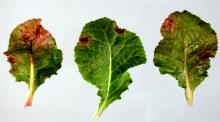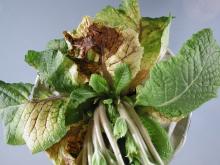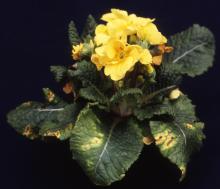Cause The bacterium Pseudomonas syringae pv. primulae can be a problem in cool, wet springs in the landscape. Has also been found as a greenhouse problem by the OSU Plant Clinic. Although the bacteria survive on the outside of the plant they must get inside and multiply in the space between plant cells (apoplast) to cause disease. These pathogenic bacteria inject several proteins and small-molecule toxins to get past host immune mechanisms. Once inside, the bacteria induce a watery, nutrient rich environment between the plant cells where they can multiply and continue colonization of the plant tissues. Bacteria also produce a protein that acts as an ice nucleus, increasing frost wounds that bacteria easily colonize and expand.
Symptoms Spots are small and water-soaked at first with a yellowish center. Later spots are irregular, circular and surrounded by a yellowish halo. Spots may coalesce and kill large areas of the leaf. Symptoms may be seen more on older leaves.
Cultural control
- Grow resistant cultivars.
- Remove and destroy infected leaves or plants.
- Space plants for good air circulation.
- Maintain a relatively dry greenhouse environment by keeping humidity below 90%, increasing spacing between plants for good air circulation, and taking care not to splash water on foliage during watering. Heating the greenhouse at night or venting around sunset may be necessary.
Chemical control Bacteria resistant to copper products have been detected in many nurseries.
- Phyton 27 at 1.3 to 2 oz/10 gal water. Group M1 fungicide. 48-hr reentry.
Reference Gleason, M.L., Daughtrey, M.L., Chase, A.R., Moorman, G.W., and Mueller, D.S. 2009. Diseases of Herbaceous Perennials. APS Press, St. Paul, MN.




